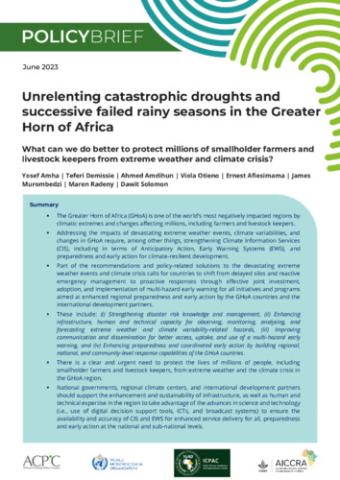Abstract
▪ The Greater Horn of Africa (GHoA) is one of the world's most negatively impacted regions by climatic extremes and changes affecting millions, including farmers and livestock keepers.
▪ Addressing the impacts of devastating extreme weather events, climate variabilities, and changes in GHoA require, among other things, strengthening Climate Information Services (CIS), including in terms of Anticipatory Action, Early Warning Systems (EWS), and preparedness and early action for climate-resilient development.
▪ Part of the recommendations and policy-related solutions to the devastating extreme weather events and climate crisis calls for countries to shift from delayed silos and reactive emergency management to proactive responses through effective joint investment, adoption, and implementation of multi-hazard early warning for all initiatives and programs aimed at enhanced regional preparedness and early action by the GHoA countries and the international development partners.
▪ These include: (i) Strengthening disaster risk knowledge and management, (ii) Enhancing infrastructure, human and technical capacity for observing, monitoring, analysing, and forecasting extreme weather and climate variability-related hazards, (iii) Improving communication and dissemination for better access, uptake, and use of a multi-hazard early warning, and (iv) Enhancing preparedness and coordinated early action by building regional, national, and community-level response capabilities of the GHoA countries.
▪ There is a clear and urgent need to protect the lives of millions of people, including smallholder farmers and livestock keepers, from extreme weather and the climate crisis in the GHoA region.
▪ National governments, regional climate centers, and international development partners should support the enhancement and sustainability of infrastructure, as well as human and technical expertise in the region to take advantage of the advances in science and technology (i.e., use of digital decision support tools, ICTs, and broadcast systems) to ensure the availability and accuracy of CIS and EWS for enhanced service delivery for all, preparedness and early action at the national and sub-national levels.

